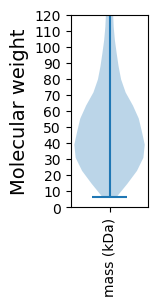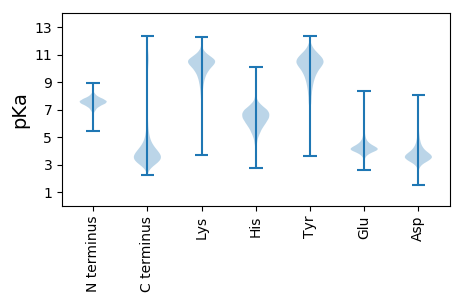
Penicillium patulum (Penicillium griseofulvum)
Taxonomy: cellular organisms; Eukaryota; Opisthokonta; Fungi; Dikarya; Ascomycota; saccharomyceta; Pezizomycotina; leotiomyceta; Eurotiomycetes; Eurotiomycetidae; Eurotiales; Aspergillaceae; Penicillium
Average proteome isoelectric point is 6.25
Get precalculated fractions of proteins

Virtual 2D-PAGE plot for 9628 proteins (isoelectric point calculated using IPC2_protein)
Get csv file with sequences according to given criteria:
* You can choose from 21 different methods for calculating isoelectric point
Summary statistics related to proteome-wise predictions



Protein with the lowest isoelectric point:
>tr|A0A135M0J1|A0A135M0J1_PENPA Uncharacterized protein OS=Penicillium patulum OX=5078 GN=PGRI_078720 PE=4 SV=1
MM1 pKa = 7.43ATLDD5 pKa = 4.37CGTDD9 pKa = 3.28ADD11 pKa = 4.56GSDD14 pKa = 3.21NGSDD18 pKa = 3.24EE19 pKa = 4.45KK20 pKa = 11.03EE21 pKa = 4.53GYY23 pKa = 10.02FSAEE27 pKa = 4.15EE28 pKa = 3.92FLSPSPYY35 pKa = 10.05LRR37 pKa = 11.84PATPQLYY44 pKa = 9.66YY45 pKa = 9.8EE46 pKa = 4.42QHH48 pKa = 6.0PAWWPVSDD56 pKa = 5.55DD57 pKa = 3.7NNFDD61 pKa = 3.66LTRR64 pKa = 11.84TCDD67 pKa = 3.4PVDD70 pKa = 3.8PVSMRR75 pKa = 11.84RR76 pKa = 11.84DD77 pKa = 3.29YY78 pKa = 10.76RR79 pKa = 11.84ARR81 pKa = 11.84RR82 pKa = 11.84PKK84 pKa = 8.12TTPSQYY90 pKa = 11.08SSDD93 pKa = 3.77DD94 pKa = 3.18TDD96 pKa = 4.4SFVSCEE102 pKa = 3.93EE103 pKa = 4.07YY104 pKa = 10.89LDD106 pKa = 4.73EE107 pKa = 5.47EE108 pKa = 4.47NPDD111 pKa = 3.77DD112 pKa = 5.72KK113 pKa = 11.26DD114 pKa = 3.64YY115 pKa = 11.39CSRR118 pKa = 11.84NGEE121 pKa = 3.92YY122 pKa = 10.74DD123 pKa = 3.2LL124 pKa = 5.98
MM1 pKa = 7.43ATLDD5 pKa = 4.37CGTDD9 pKa = 3.28ADD11 pKa = 4.56GSDD14 pKa = 3.21NGSDD18 pKa = 3.24EE19 pKa = 4.45KK20 pKa = 11.03EE21 pKa = 4.53GYY23 pKa = 10.02FSAEE27 pKa = 4.15EE28 pKa = 3.92FLSPSPYY35 pKa = 10.05LRR37 pKa = 11.84PATPQLYY44 pKa = 9.66YY45 pKa = 9.8EE46 pKa = 4.42QHH48 pKa = 6.0PAWWPVSDD56 pKa = 5.55DD57 pKa = 3.7NNFDD61 pKa = 3.66LTRR64 pKa = 11.84TCDD67 pKa = 3.4PVDD70 pKa = 3.8PVSMRR75 pKa = 11.84RR76 pKa = 11.84DD77 pKa = 3.29YY78 pKa = 10.76RR79 pKa = 11.84ARR81 pKa = 11.84RR82 pKa = 11.84PKK84 pKa = 8.12TTPSQYY90 pKa = 11.08SSDD93 pKa = 3.77DD94 pKa = 3.18TDD96 pKa = 4.4SFVSCEE102 pKa = 3.93EE103 pKa = 4.07YY104 pKa = 10.89LDD106 pKa = 4.73EE107 pKa = 5.47EE108 pKa = 4.47NPDD111 pKa = 3.77DD112 pKa = 5.72KK113 pKa = 11.26DD114 pKa = 3.64YY115 pKa = 11.39CSRR118 pKa = 11.84NGEE121 pKa = 3.92YY122 pKa = 10.74DD123 pKa = 3.2LL124 pKa = 5.98
Molecular weight: 14.24 kDa
Isoelectric point according different methods:
Protein with the highest isoelectric point:
>tr|A0A135LUK8|A0A135LUK8_PENPA Uncharacterized protein OS=Penicillium patulum OX=5078 GN=PGRI_079010 PE=4 SV=1
MM1 pKa = 6.97FCLRR5 pKa = 11.84ARR7 pKa = 11.84AVPSTFRR14 pKa = 11.84ATTSAMRR21 pKa = 11.84TSMSRR26 pKa = 11.84FAQIPQQPSTPSTMLSSRR44 pKa = 11.84SFSSLLSTPTRR55 pKa = 11.84FQPSRR60 pKa = 11.84TLGARR65 pKa = 11.84LSSPITATASAFSPLSSLLSQKK87 pKa = 9.18TPSQSRR93 pKa = 11.84SFSASASLGVRR104 pKa = 11.84RR105 pKa = 11.84VTFRR109 pKa = 11.84PSRR112 pKa = 11.84RR113 pKa = 11.84VQKK116 pKa = 10.3RR117 pKa = 11.84RR118 pKa = 11.84HH119 pKa = 5.75GYY121 pKa = 9.09LARR124 pKa = 11.84KK125 pKa = 9.08KK126 pKa = 10.39DD127 pKa = 3.6RR128 pKa = 11.84NGRR131 pKa = 11.84KK132 pKa = 6.83TLIRR136 pKa = 11.84RR137 pKa = 11.84TLKK140 pKa = 10.34GRR142 pKa = 11.84KK143 pKa = 7.8EE144 pKa = 4.02LSWW147 pKa = 4.66
MM1 pKa = 6.97FCLRR5 pKa = 11.84ARR7 pKa = 11.84AVPSTFRR14 pKa = 11.84ATTSAMRR21 pKa = 11.84TSMSRR26 pKa = 11.84FAQIPQQPSTPSTMLSSRR44 pKa = 11.84SFSSLLSTPTRR55 pKa = 11.84FQPSRR60 pKa = 11.84TLGARR65 pKa = 11.84LSSPITATASAFSPLSSLLSQKK87 pKa = 9.18TPSQSRR93 pKa = 11.84SFSASASLGVRR104 pKa = 11.84RR105 pKa = 11.84VTFRR109 pKa = 11.84PSRR112 pKa = 11.84RR113 pKa = 11.84VQKK116 pKa = 10.3RR117 pKa = 11.84RR118 pKa = 11.84HH119 pKa = 5.75GYY121 pKa = 9.09LARR124 pKa = 11.84KK125 pKa = 9.08KK126 pKa = 10.39DD127 pKa = 3.6RR128 pKa = 11.84NGRR131 pKa = 11.84KK132 pKa = 6.83TLIRR136 pKa = 11.84RR137 pKa = 11.84TLKK140 pKa = 10.34GRR142 pKa = 11.84KK143 pKa = 7.8EE144 pKa = 4.02LSWW147 pKa = 4.66
Molecular weight: 16.44 kDa
Isoelectric point according different methods:
Peptides (in silico digests for buttom-up proteomics)
Below you can find in silico digests of the whole proteome with Trypsin, Chymotrypsin, Trypsin+LysC, LysN, ArgC proteases suitable for different mass spec machines.| Try ESI |
 |
|---|
| ChTry ESI |
 |
|---|
| ArgC ESI |
 |
|---|
| LysN ESI |
 |
|---|
| TryLysC ESI |
 |
|---|
| Try MALDI |
 |
|---|
| ChTry MALDI |
 |
|---|
| ArgC MALDI |
 |
|---|
| LysN MALDI |
 |
|---|
| TryLysC MALDI |
 |
|---|
| Try LTQ |
 |
|---|
| ChTry LTQ |
 |
|---|
| ArgC LTQ |
 |
|---|
| LysN LTQ |
 |
|---|
| TryLysC LTQ |
 |
|---|
| Try MSlow |
 |
|---|
| ChTry MSlow |
 |
|---|
| ArgC MSlow |
 |
|---|
| LysN MSlow |
 |
|---|
| TryLysC MSlow |
 |
|---|
| Try MShigh |
 |
|---|
| ChTry MShigh |
 |
|---|
| ArgC MShigh |
 |
|---|
| LysN MShigh |
 |
|---|
| TryLysC MShigh |
 |
|---|
General Statistics
Number of major isoforms |
Number of additional isoforms |
Number of all proteins |
Number of amino acids |
Min. Seq. Length |
Max. Seq. Length |
Avg. Seq. Length |
Avg. Mol. Weight |
|---|---|---|---|---|---|---|---|
0 |
5009552 |
66 |
7334 |
520.3 |
57.64 |
Amino acid frequency
Ala |
Cys |
Asp |
Glu |
Phe |
Gly |
His |
Ile |
Lys |
Leu |
|---|---|---|---|---|---|---|---|---|---|
8.392 ± 0.018 | 1.175 ± 0.009 |
5.735 ± 0.017 | 6.212 ± 0.029 |
3.802 ± 0.017 | 6.756 ± 0.023 |
2.412 ± 0.011 | 5.169 ± 0.019 |
4.74 ± 0.019 | 8.95 ± 0.029 |
Met |
Asn |
Gln |
Pro |
Arg |
Ser |
Thr |
Val |
Trp |
Tyr |
|---|---|---|---|---|---|---|---|---|---|
2.267 ± 0.009 | 3.765 ± 0.012 |
6.043 ± 0.03 | 4.023 ± 0.016 |
5.884 ± 0.022 | 8.284 ± 0.028 |
5.988 ± 0.017 | 6.144 ± 0.018 |
1.463 ± 0.01 | 2.797 ± 0.013 |
Most of the basic statistics you can see at this page can be downloaded from this CSV file
Proteome-pI is available under Creative Commons Attribution-NoDerivs license, for more details see here
| Reference: Kozlowski LP. Proteome-pI 2.0: Proteome Isoelectric Point Database Update. Nucleic Acids Res. 2021, doi: 10.1093/nar/gkab944 | Contact: Lukasz P. Kozlowski |
